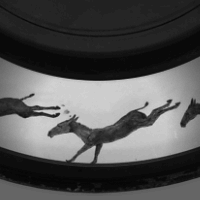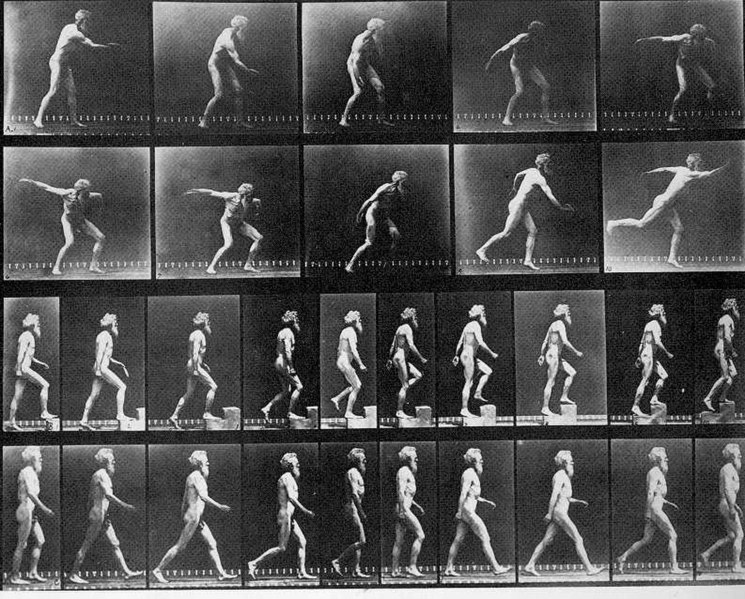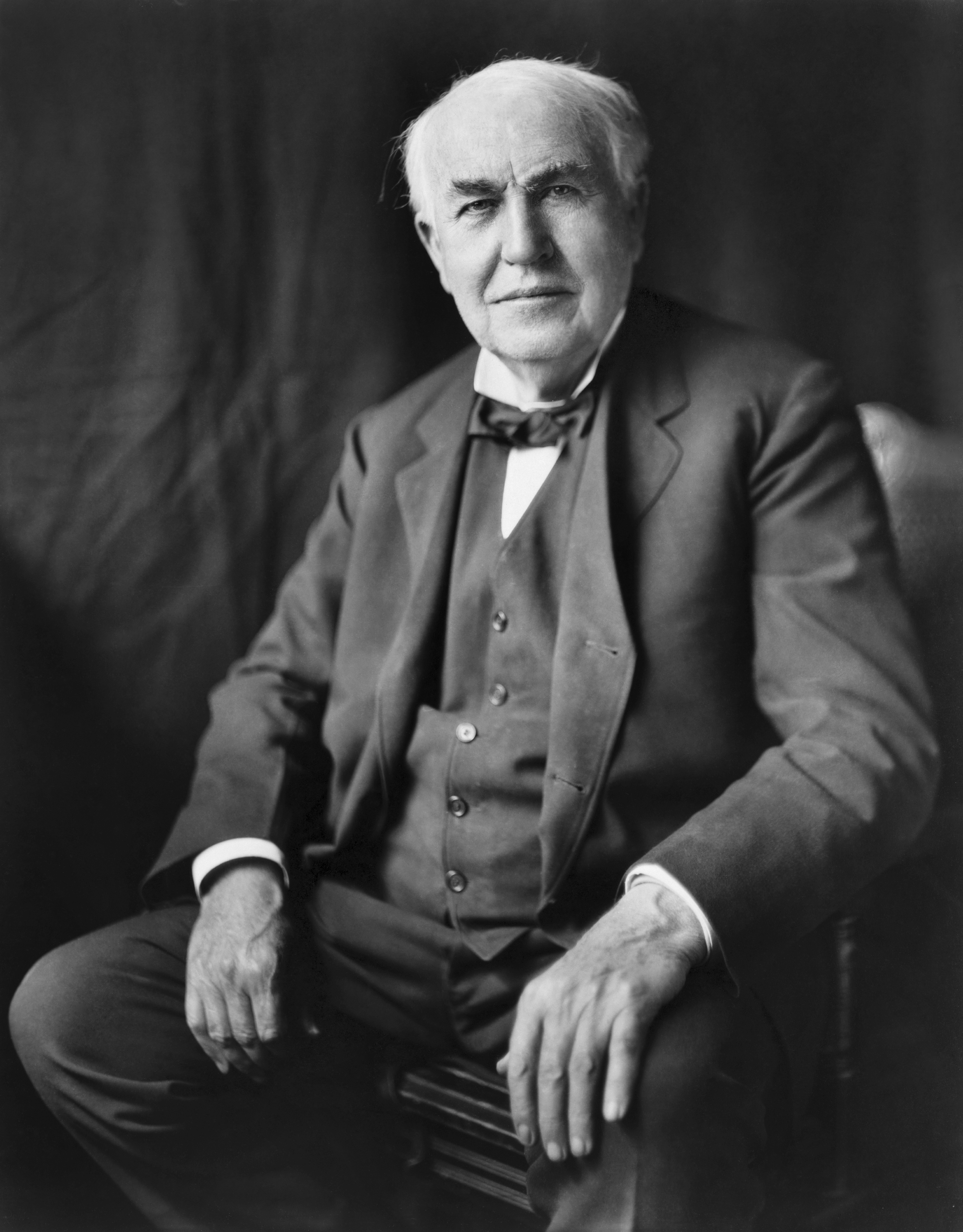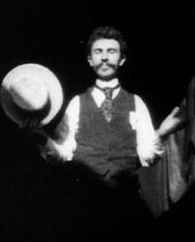.
Chapter:
INT |
1 |
2 |
3 |
4 |
5
|
6
|
7
|
8 |
9 |
10 |
11 |
12 |
13
C
H
A
P
T
E
R
7/6
For suggested
movies
Click Here.
PRESENTATION
 Edward
J. Muybridge
Edward
J. Muybridge
(April 9, 1830 – May 8, 1904) was an English photographer,
known primarily for his early use of multiple cameras to
capture motion, and his zoopraxiscope, a device for
projecting motion pictures that pre-dated the celluloid film
strip.


A
popularly-debated question of the day was
whether all four of a horse's hooves left the
ground at the same time during a gallop. Leland
Stanford (the Governor of California) sided with
this assertion - called unsupported transit.
He hired Muybridge to settle the question.
In 1878 Muybridge photographed a horse in fast
motion using a series of twenty-four cameras.
Trip-wires attached to each camera's
shutter were triggered by the horse's hooves.

Muybridge
started by photographing landscaped of Yosemite and San
Francisco.
 At
the Chicago 1893 World's Columbian Exposition, Muybridge
gave a series of lectures on the Science of Animal
Locomotion in the Zoopraxographical Hall - built specially
for that purpose. He used his zoopraxiscope to show his
moving pictures to a paying public. This was the very
first commercial movie theater.
At
the Chicago 1893 World's Columbian Exposition, Muybridge
gave a series of lectures on the Science of Animal
Locomotion in the Zoopraxographical Hall - built specially
for that purpose. He used his zoopraxiscope to show his
moving pictures to a paying public. This was the very
first commercial movie theater.



OTHER WORKS








William Kennedy Dickson
Genius is one percent inspiration, ninety-nine percent
perspiration." - Thomas Alva Edison, Harper's Monthly
(September 1932)

Thomas
Alva Edison (February 11, 1847 – October 18, 1931) invented
the motion picture camera or "Kinetograph". He did the
electromechanical design, while his employee W.K.L. Dickson,
a photographer, worked on the photographic and optical
development. In 1891, Thomas Edison built a Kinetoscope - or
peep-hole viewer. This device was installed in penny arcades
where people could watch short films. The kinetograph and
kinetoscope were both first publicly exhibited May 20, 1891.
He was one
of the first inventors to apply the principles of mass
production and large teamwork to the process of invention,
and created the first industrial research laboratory. Edison
held 1,093 U.S. patents. His inventions include: the
electric light bulb, His first power plant was on Manhattan
Island, New York.
The movie
camera flashes a series of still frame images onto the movie
screen at a rate of 24 frames per second. The retina retains
the image for 1/10th of a second after it
disappears – creating the illusion of movement. The book
attributed this theory to Ptolemy; it’s called persistence
of vision.
FORM CUT AND MONTAGE CUT
Subjective Viewpoint (p 159) Shot from the perspective
of the character.
Objective Viewpoint Shot from the viewpoint
of an omnipresent viewer.
FOCUS:
DEPTH OF FIELD
Rack or Differential Focus: (p160)
The main object is clear, and the remaining
scene blurs out.
Camera Angles
in Dead Man Walking
CLASSIFICATIONS
ANIMATION
XVIVO Scientific Animation
MUTO a wall-painted
animation by BLU
Narrative /
Fictional - follows a
plot
Pan's Labyrinth
Look for these Shots:
1. Long Shot
2. Medium
Shot
3. Depth of
Field
4. Close up
of painting / pan / close up of her and shoes
5. Unreal
Objective- a nonexistent point of view
6. Dolly or
Tracking Shot
Cinéma
Vérité - French for
"cinema truth"
It's a
documentary style that emphasizes: natural light, hand-held
cameras, realism, and as little director intervention as
possible. Movies like Cloverfield have copied these
techniques to give the movie a sense of realism, but are
considered by many to not be of the genera.
CLOVERFIELD
Documentary
Taxi To The Dark Side
Bowling for Columbine
Broken Rainbow
On December 1974 Congress passed Public
Law 93-531 "The Navajo-Hopi Land Settlement Act". It
authorized the partitioning of the Joint Use Area (JUA) and
established the Navajo-Hopi Indian Relocation Commission (NHIRC)
which moved Navajo people from the reservation lands. The
most traditionally and culturally intact Dineh (Navajo)
people were forced to re-locate to cities.
This 1985 documentary traces the history of both tribes and
the events that led to this devastating land grab by Peabody
Coal and Bechtel Corporations, assisted by our own
government (major players included Barry Goldwater, Morris
Udall, John McCain, and President Ford). The goal: access to
coal and uranium resources.
Avant Garde /
Absolute - no plot,
pure movement
American Beauty
Marco
Brambilla:
Ghost
Civilization
Flashback
Cathedral
CINEMA APPRECIATION
SUGGESTED FILMS
My left foot- the story of Christy Brown -
(verisimilitude)
Pleasantville
Memento
-
(editing)
Pollock
Amadeus
The Piano
The Pianist
Romeo and Juliet
Mankind Is No Island
by Jason van Genderen
Idiot with a Tripod
